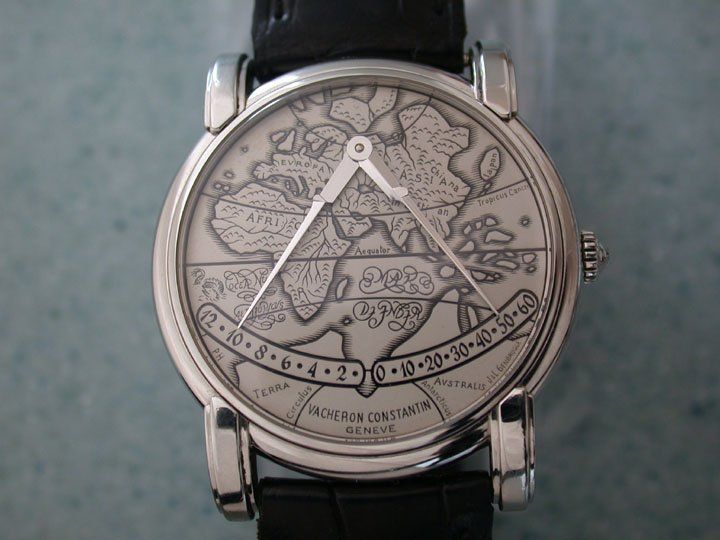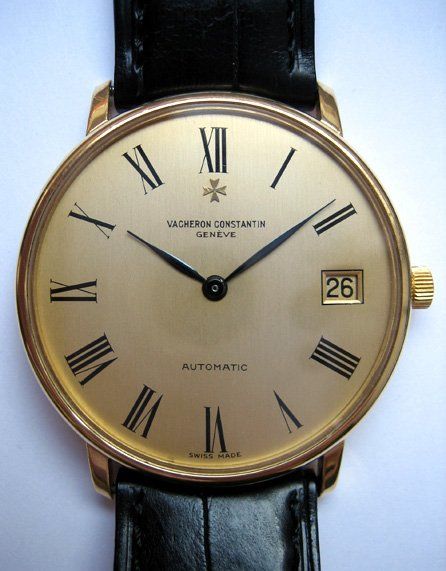
WHL
[VC Moderator]
4922

Watch Review-VC Patrimony Traditionnelle Self Winding
Making It New
When Ezra Pound exhorted “Make it new,” he was challenging his
contemporaries to find value in the cultural works of the past and to
recast them for the present. Pound himself used the techniques of
translation, imitation, allusion, and quotation to achieve his artistic
goals. An overarching challenge for watch designers at historical firms
is to come up with designs that respect their firm’s heritage while
also remaining relevant to contemporary tastes. That is, to “make it
new.” They use the horological equivalents to Pound’s linguistic
techniques to make watches that would be recognized as belonging to
their heritage but also could only be of this time. Recent examples
that successfully balance heritage and fashion are Breguet’s La
Tradition, Patek Philippe’s World Time watches and Audemars Piguet’s
Jules Audemars line. (Sometimes these companies intentionally tilt more
toward fashion with the potential of upsetting long time clients but
also with the hope of finding a new generation of buyers. Audemars
Piguet is testing this route with its Millenary line and Vacheron
Constantin is making a bold experiment with its Quai de l’Ille,
launched at SIHH 2008. But that is a subject for another article...)
Vacheron Constantin walks this line between heritage and fashion, and
has both successes and disappointments in its catalog. In the 1990’s,
with the renaissance of mechanical watchmaking underway, the company
inaugurated some lines that tried to navigate this design dichotomy.
Les Essentials was set up to offer clients simple watches in a
traditional vein: clean dial with unadorned markers or Roman Numberals,
and baton hands. There was also Les Historiques, which took inspiration
from great watch designs in the company’s history. While there
were some successes, such as the Historiques Chronograph and the
Patrimony Extra-Plate, many of these watches come across as
unflattering imitations of the originals. Perhaps the company’s
greatest success of this time was the Mecator, which built on Vacheron
Constantin’s history of making watches with alternative time display,
used a case modeled on the Reference 4735 from the 1950’s, and had a
dial depicting a map in either an enamel or an engraved format.

With the purchase of HDG in 1998, Vacheron Constantin acquired the expertise to design and manufacture movements in-house, an essential requirement for high-end firms in the late 1990’s. With the launch of the caliber 1790 in the Malte Tourbillon in 2000 and the caliber 1400 in the Malte Grande Classique two years later, Vacheron Constantin was off and running. The development of an automatic movement was anticipated by collectors with excitement. In 2005, Vacheron Constantin launched it’s automatic movement in two exciting, limited lines: the Metiers d’art and the Jubile 1755. It was only a matter of time before a three hand watch with date was introduced.
Patrimony
Following the breathtaking anniversary collection that celebrated the firm’s 250 years of continuous operation in 2005, Vacheron Constantin launched the Patrimony Contemporaine collection in 2006. That line currently contains a simple two hand manual winding watch and a three hand automatic watch, with or without date. The watches are characterized by slim profiles, large diameters, slender trapezoid hour-markers, baton hands, domed dials and a minute-track beaded with gold cabochons.

The Patrimony Traditionnelle line was launched in 2007 and currently consists of three watches: the Patrimony Traditionnelle “Calibre 2755,” a haute horology tour de force with tourbillon, minute repeater, and perpetual calendar; the Patrimony Traditionnelle Skeleton Perpetual Calendar, which takes inspiration in its decorative chasing from the design motifs of the Eiffel Tower and firmly reestablishes Vacheron Constantin at the pinnacle of skeletonized watchmaking; and the Patrimony Traditionnelle Self-Winding, a modern take on the classic three hand watch with guichet date that shares the aesthetic values at the core of the Traditionnelle line. Those traits are a fine bezel, knurling around the caseback, facetted trapezoid hour-markers – double at 12 and 6 o’clock – dauphine hands, dials in several silvered tones, and a case and lugs tiered with clean, straight lines.

Some History
Vacheron Constantin has been making distinguished automatic watches with guichet date since the 1950’s. Vacheron Constantin’s early automatic watches are still popular today and are in demand at auction houses and vintage watch dealers. The first automatic-date watches were based on the legendary 1072 caliber and are typically 35 mm in diameter and pleasantly chunky at 10mm thick. These watches often have some stylistic flair with fancy lugs.

As with manual winding watches, automatic watches became thinner as they developed and Vacheron Contantin used the very thin JLC based 1120, only 2.45 mm thick in its simplest form, 3.05 mm with the date. This caliber is still in use today, though it is most often found as a base for complicated watches and also nicely showcases Vacheron Constantin’s expertise in skeletonizing. The next generation automatic from JLC that Vacheron Constantin used was VC’s caliber 1126, based on the JLC 889, which while thicker than the 1120, was also less expensive to manufacture and easier to service. Finally, in the 1990’s VC occasionally used the caliber 1131, based on a Girard Perregaux ebache, most famously in the Overseas Chronometer.
With many of the early 1120-caliber based watches, the thinness was what made the watches elegant. The watches did not have much flair like the earlier 1072 watches. While demonstrating excellent watchmaking, they don’t resonate in today’s market where design matters to a much greater degree.

One of the top 889-based watches was the modern Chronometer Royal, with the historical Alpha hands and a mixed set of roman and applied hour indices.

While the pricinpal dress watch using the 1311 was nicely done, with a modern update of classic sun ray finishing on the dial, here in guilloche, the fact that in a day when many companies were placing in-house movements in their watches while Vacheron Constantin was using a GP movement, makes it a nice, but less than ideal, watch.

A first draft of the new Patrimony Traditionnelle came in a limited edition for the Japanese market. It does not have the guichet date.

The Patrimony Traditionnelle Self-Winding
Case
The Patrimony Traditionnelle comes in a 38 mm diameter case with a slim profile. All surfaces are polished. Breaking of that potential monotony is a step along the side of the case, which continues between the lugs, even though it won’t be noticed. The lugs are also tiered, but now the line tapers down toward the wrist.

When viewing the watch head on the case and lugs appear plain. As with the Jubile 1755, only when catching a glimpse of the watch’s profile does the refinement in it’s design become noticeable.

The crown is small, appropriate for an automatic watch in which it will not often be used, but not particularly user friendly. It does not lock down. The first position is for quicksetting the date and the second position is for time-settting.
Like with most watches made in this day and age, the caseback has a sapphire crystal to allow a view of the movement. The caseback has an attractive knurling that has also been seen on the Jubile set of watches. It does occasionally snag a wrist hair.
Dial
Historically, Vacheron Constantin has employed two-tone dials in a number of ways. In its triple calendar watches, the date track would typically be in a hue different from the rest of the dial:

For the firm’s 200th anniversary, a special set of watches were made with the Maltese Cross embossed on the dial:

And sometimes, the use of multiple tones it is used to break up the monotony of the dial in an attractive way:

With the Patrimony Traditionnelle, Vacheron Constantin revisits the two tone dial with a minute track in a darker tone than the rest of the dial, which is repeated in the outer section of the sub second dial:

Also in the sub second track is polished circle that matches the applied markers in color.

The hour markers are applied. Doubled at 12 and 6, these faceted markers give the dial a nice depth, as does the tiered frame of the date window. The hands are given a half-polished, half-frosted finish.

The most interesting aspect of this dial is the placing of the sub seconds at 9, balancing it with the date window at 3. This “balanced asymmetry” is becoming a calling card of many modern Vacheron Constantin watches, as with the power reserve indicator in the Jubile 1755, the new Malte Power Reserve and Date, and the Overseas Dual Time among other watches.
Movement
Animating the Patrimony Traditionnelle is Vacheron Constantin’s in-house caliber 2455. This movement is 25.60 mm in diameter and a slim 3.60 mm thick. The balance beats at 28,800 vibrations per hour and the power reserve is about 40 hours. Like all movements that Vacheron Constantin makes in-house, the caliber 2455 is stamped with the Geneva Hallmark, ensuring a high standard of technical and visual finish (Vacheron Constantin’s website has an excellent tutorial on the Geneva Hallmark, complete with pictures to illustrate the criteria).


In addition to the 27 jewels, the beautifully engine-turned rotor is mounted on ceramic ball bearing to eliminate the need for lubrication and extending the life of the system. There is a stop seconds mechanism to allow for precise time-setting.
Variations on a Theme
Fifty years ago Vacheron Constantin would offer many variations on it’s basic watches. If you didn’t like the shape of lugs on one model, there were a dozen other styles to choose from. If you didn’t like a particular dial, there would soon be a variation that might appeal. Such extravagant diversity doesn’t exist in today’s market. If you want a classical automatic dress watch with guichet date from Vacheron Constantin you have two basic choices: Patrimony Contemporaine or Patrimony Traditionnelle. Fortunately for those in the market for a three hand watch with date, Vacheron Constantin has made some compelling watches that sure to stand the test of time.
The Patrimony Traditionnelle is also available in a rose gold case and a silver dial:

as well as in a special Boutique Edition, available only at Vacheron Constantin boutiques, that pairs the rose gold case with a black dial, as in all Boutique Edition watches, while retaining the two-tone dial of the standard model. This Boutique Edition also has a black background for the date indication:

`
Bill

Watch Review-VC Patrimony Traditionnelle Self Winding
Thanks for the excellent report





















